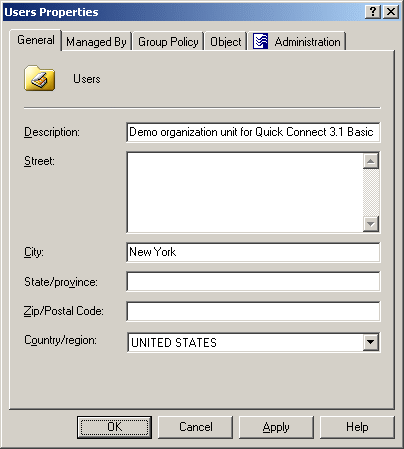To find an Organizational Unit, select the domain you want to search, and click Find. In the Find window, select Organizational Units from the Find list, specify your search criteria, and start the search. In the search results list, you can right-click Organizational Units and use commands on the shortcut menu to perform management tasks.
For step-by-step instructions on how to search for Organizational Units, see Searching for an Organizational Unit.
You can modify the properties of Active Directory Organizational Units (OUs) with the Active Roles Console.
To modify Organizational Unit properties
-
In the Console tree, locate the OU you want to modify.
-
Right-click the OU, then click Properties.
Figure 21: Modifying Organizational Unit properties

-
Use the tabs in the Properties dialog to view or modify properties of the OU.
-
If you want to view or modify additional properties (those for which the tabs in the Properties dialog do not provide data entries), navigate to the Object tab and click Advanced Properties.
-
After setting all the properties you want, click OK.
NOTE: Consider the following when modifying object properties:
-
In the wizard, some property labels may be displayed as hyperlinks. The hyperlink indicates that Active Roles enforces certain policy restrictions on the property. To examine policy details, click the hyperlink: the policy information is displayed. For more information, see Getting policy-related information.
The policy information is also displayed whenever you supply a property value that violates a policy restriction. The wizard cannot proceed until you enter an acceptable value.
-
To modify properties for multiple objects, press and hold Ctrl, then click each object. Right-click the selection, then click Properties.
-
You can use the Properties dialog to view or modify any property of the object by navigating to the Object tab and clicking Advanced Properties. In the Advanced Properties window you can manage all properties, including those that cannot be accessed via the Properties dialog itself.
You can also display the Advanced Properties window by right-clicking the object and selecting All Tasks > Advanced Properties.
-
To locate the object that you want to modify, use the Find function of Active Roles. Once you found the object, open the Properties page by right-clicking the object, and clicking Properties.
You can rename Active Directory Organizational Units (OUs) with the Active Roles Console.
To rename an Organizational Unit
-
In the Console tree, locate the OU you want to rename.
-
Right-click the OU, then click Rename.
-
Type a new name, then press Enter.
NOTE: Consider the following when renaming an object:
-
The behavior of the dialog may vary depending on the configuration of Active Roles policies. To determine whether a given item in the dialog is under the control of a certain policy, observe the text label next to the item: the underlined text label indicates that some policy restrictions are in effect. Click underlined text labels to examine the policies that govern the behavior of the dialog. For more information, see Getting policy-related information.
-
To locate the object you want to rename, use the Find function of Active Roles. Once you found the object, rename it by selecting it in the list of search results, right-clicking it, clicking Rename, then specifying the new name. To apply the new name, press Enter.
You can move Organizational Units (OUs) from one Active Directory container to another with the Active Roles Console.
To move an Organizational Unit
-
In the Console tree, locate and select the folder that contains the OU you want to move.
-
In the details pane, right-click the OU and click Move to display the Move dialog.
-
In the Move dialog, select the folder to which you want to move the OU, then click OK.
NOTE: Consider the following when moving an object:
-
With Active Roles, directory objects can only be moved within the same domain. This means that the folder to which you want to move the object must belong to the same domain as the object.
-
You can move multiple objects at a time with the Move dialog. To open the dialog, select the objects, right-click the selection, and click Move. To select multiple objects, press and hold Ctrl, then click each object.
-
To locate the object that you want to move, use the Find function of Active Roles. Once you found the accounts, open the Move dialog by right-clicking the object, and clicking Move.
-
The Console provides the drag-and-drop function for moving objects. To move objects, you can drag the selection from the details pane to a destination container in the Console tree.

